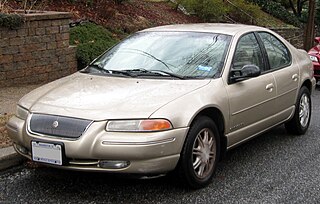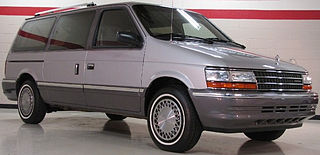Related Research Articles
Dodge is an American brand of automobiles and a division of Stellantis, based in Auburn Hills, Michigan. Dodge vehicles have historically included performance cars, and for much of its existence Dodge was Chrysler's mid-priced brand above Plymouth.

Eagle was a brand of the Chrysler Corporation following the purchase of American Motors Corporation (AMC) in 1987 and marketed through the end of the 1998 model year. It was aimed at the enthusiast driver and promoted as more "European" than the automaker's similar models.

Plymouth was a brand of automobiles produced by Chrysler Corporation and its successor DaimlerChrysler. The brand was launched in 1928 to compete in what was then described as the "low-priced" market segment that was dominated by Chevrolet and Ford. It became a high-volume seller for the automaker until the late 1990s. Plymouth cars were marketed primarily in the United States. The brand was withdrawn from the marketplace in 2001. The Plymouth models that were produced up to then were either discontinued or rebranded as Chrysler or Dodge.

The Dodge Rampage was a subcompact unibody coupe utility based on Chrysler's L platform and manufactured from 1982 to 1984. First released as a 1982 model, the Rampage was later joined for 1983 by its rebadged variant, the Plymouth Scamp.

The Chrysler Cirrus is a mid-sized 4-door notchback sedan introduced by Chrysler motors for the 1995 model year. Built on the Chrysler JA platform, the 4-door notchback sedan joined Chrysler's roster of "Cloud Car" models drawing their names from meteorological terms, including the mid-priced Dodge Stratus it was based on introduced at the same time, and the low-priced Plymouth Breeze variant a year later.

The Dodge Challenger is the name of three different generations of automobiles produced by American automobile manufacturer Dodge. However, the first use of the Challenger name by Dodge was in 1959 for marketing a "value version" of the full-sized Coronet Silver Challenger.

Front-wheel drive (FWD) is a form of engine and transmission layout used in motor vehicles, where the engine drives the front wheels only. Most modern front-wheel drive vehicles feature a transverse engine, rather than the conventional longitudinal engine arrangement generally found in rear-wheel drive and four-wheel drive vehicles.

The Dodge Omni is a subcompact car that was produced by Chrysler Corporation from the 1978 to 1990 model years. The first Chrysler model line produced with front-wheel drive, the Omni and Horizon were also the first front-wheel drive economy cars assembled in the United States. Marketed for eleven years with very few changes, around 2,500,000 Omnis and Horizons were built with the Plymouth badged versions more popular than the Dodge branded models.

The Chrysler minivans are a series of minivans that have been produced and marketed by the American automaker Chrysler since the 1984 model year. Currently in its sixth generation, the model line is marketed worldwide, primarily in North America and Europe. Introduced as the Dodge Caravan and Plymouth Voyager, the Chrysler minivans have been marketed under a variety of nameplates under the Chrysler, Plymouth, Dodge, and Ram brands; through the use of rebadging, the model line has also been marketed under the Lancia and Volkswagen brands.

The Ford Aerostar is a range of vans that was manufactured by Ford from the 1986 to the 1997 model years. The first minivan produced by Ford, the model line was marketed against the Chevrolet Astro/GMC Safari and the first two generations of the Chrysler minivans. Introduced shortly before the Ford Taurus, the Aerostar derived its name from its slope-nosed "one-box" exterior.

The Chrysler/Dodge/Plymouth Neon is a front-engine, front-wheel drive compact car that was introduced in January 1994 for model year 1995 by Chrysler's Dodge and Plymouth divisions in two- and four-door bodystyles over two generations.

The Chevrolet Lumina APV is a minivan that was produced by the Chevrolet division of General Motors. The first front-wheel drive minivan sold by Chevrolet, the Lumina APV was sold in a single generation from the 1990 to 1996 model years. Marketed alongside the Pontiac Trans Sport and Oldsmobile Silhouette, the Lumina APV competed against the Dodge Grand Caravan/Plymouth Grand Voyager, the extended-length Ford Aerostar, and the Mazda MPV.

Chrysler Europe was the American automotive company Chrysler's operations in Europe from 1967 through 1978. It was formed from the merger of the French Simca, British Rootes and Spanish Barreiros companies. In 1978, Chrysler divested these operations to PSA Peugeot Citroën.

The Dodge Ramcharger is a large sport utility vehicle built by Dodge from 1974 to 1993, based on a shortened-wheelbase version of the Dodge D Series/Ram pickup truck chassis. A Plymouth version, named the Plymouth Trail Duster, offered from 1974 to 1981, was Plymouth's only SUV.

The Plymouth Prowler, later the Chrysler Prowler, is a retro-styled production sports car manufactured and marketed from 1997 to 2002 by DaimlerChrysler, based on the 1993 concept car of the same name.
The Ultradrive is an automatic transmission manufactured by Chrysler beginning in the 1989 model year.
In the context of the automobile industry, downsizing is a practice used to transition vehicles from one size segment to another. Commenced during the Malaise era, downsizing is done in response to consumer and government demands influencing vehicle design. As vehicle product lines completed their model cycles, automobile manufacturers developed the next generation of a vehicle with a smaller exterior footprint to allow for weight reduction and increased fuel economy, using a shortened wheelbase and body length.

The first-generation Chrysler minivans are a series of minivans produced and marketed by the Chrysler Corporation from the 1984 to the 1990 model years. Introduced as the first minivans from an American-brand manufacturer and popularizing the minivan as a vehicle, the Dodge Caravan and Plymouth Voyager were launched ahead of chief competitors Chevrolet Astro/GMC Safari and Ford Aerostar.

The second-generation Chrysler minivans are a series of minivans that were manufactured and marketed by Chrysler Corporation in North America and Europe from 1991 to 1995. Officially designated the AS platform by Chrysler, the second-generation minivans were an extensive revision of the first-generation chassis and body. As before, passenger and cargo configurations were sold by Dodge, Plymouth, and Chrysler divisions. The first minivans offered with driver-side airbags and with optional integrated child safety seats, the second-generation Chrysler minivans offered all-wheel drive as an option for the first time; a manual transmission would be offered for the last time in the North American market.

The third-generation Chrysler minivans are a series of passenger minivans that were marketed by the Chrysler Corporation from the 1996 to 2000 model years. Designated the NS platform by Chrysler, these minivans were sold by Chrysler, Dodge and Plymouth divisions in passenger configurations; minivans were exported under the Chrysler brand. While the second-generation AS platform was a revision of the original vans, the NS platform marked the first ground-up redesign of the Chrysler vans since their 1984 introduction, ending the use of components from K-Car derivatives.